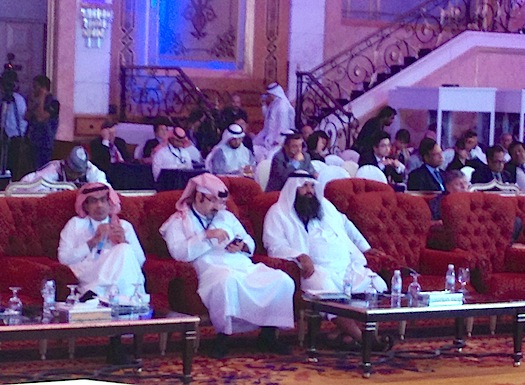Australians Steve Ahern and Mike McCluskey spoke last week at the Asia Media Summit in Saudi Arabia, updating participants on latest trends in technology and discussing the changing nature of public broadcasting.
In the changing technological environment, it is imperative that work flow and organisational structures evolve to keep pace with the new media environment, shrinking revenues and changing audience expectations, Ahern told the summit.
“If you are still doing things the same way you were doing them five years ago, you should be worried. If your organisational structure is the same as it was ten years ago, someone should resign,” said Ahern.
He outlined the new tools that can be used by journalists and program makers to capture, edit and file digital content to multiple platforms, and displayed the apps he uses on his phone as an example of mobile content creation (pictured). He recommends using smartphone apps such as Wave Pad for audio capture and Vimeo for video file transfer.
Reporters should also use external mics for quality and to bypass the automatic level and eq controls that are installed in a phone’s normal microphone, and should consider small external lenses for video capture, according to Ahern.
 In a workshop on Public Broadcasting facilitated by former Radio Australia CEO Mike McCluskey, a range of recommendations were brought forward to help public broadcasters respond professionally to changing priorities, while serving their public service mandate.
In a workshop on Public Broadcasting facilitated by former Radio Australia CEO Mike McCluskey, a range of recommendations were brought forward to help public broadcasters respond professionally to changing priorities, while serving their public service mandate.
Public Service Broadcasters must understand that media is more art than science so that they can become more relevant in modern world. This demands that PSB should be creative and entertaining. They must have articulated values that reflect independence, integrity, truth, impartiality, plurality and public interest among other values relevant to each country.
Some characteristics of successful modern Public Service Broadcasters (PSBs) are:
- Connecting with audiences, the more audience participate the more we will get success
- Content must be accurate, reliable and competitive, adding values to people’s lives
- Responding to audience that is fragmented and found in different platforms
- Content must be innovative and interactive
- Relevance, independence (content is independent from vested interests including government and commercial interests )
- Plurality of views that reflects a diverse society
- Avoid hate speech but letting communities have a voice
- Being there in times of disaster and conflict-fundamental in being a broadcaster
To deal with stiff competition, PSBs must have their own strategy, vision, objectives, target audience, programs with own identity. They should undertake research and understand how they are perceived by their audiences. A constant focus on must be on how to use resources effectively.
It is vital to inform political leaders informed about the role being performed by PSB’s and its importance. This must reflect the need for true independent media within a society in context with the rest of the media market. To make people understand easily distinction between various broadcasting models, we need to focus on profit. Once you explain to people how the profit is used, the distinction becomes clear: the return on investment from Public Service Broadcaster goes back to benefit the public.
A competitive edge for public broadcasters is their ethics and codes of conduct. PSBs need to work harder, but these things that may be seen as restrictions can also be seen as unique benefits that public broadcasters have when compared with other sectors.

Dr Mike McCluskey is an International Media & Broadcast Consultant. Steve Ahern is founding editor of radioinfo, CEO of IMBA and an international trainer and consultant.

